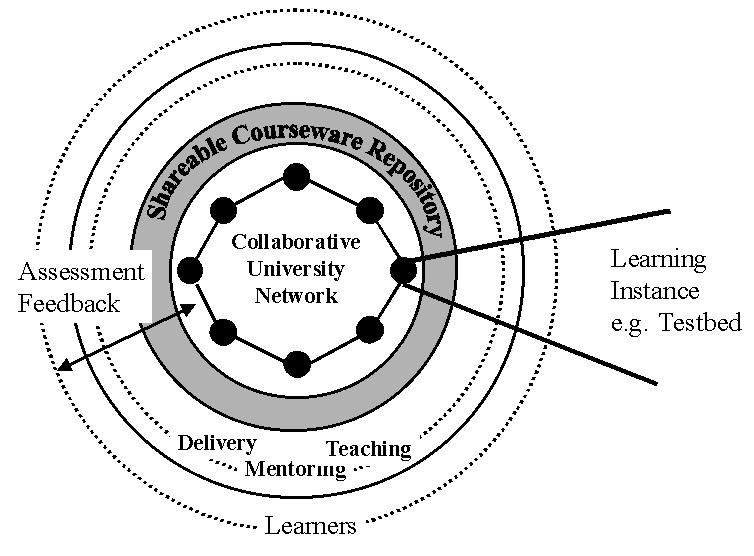
Discussion of March 21 2000
Attendees
Larry Dennis(
dennisl@csit.fsu.edu), Peter Dragovitsch (PDragovitsch@oddl.fsu.edu ), Ian Douglas(idouglas@lsi.fsu.edu), Geoffrey Fox(fox@csit.fsu.edu), Carole Hayes(chayes@oddl.fsu.edu), Chris Lacher(CLacher@oddl.fsu.edu), Sara Stoecklin(stoeckli@cis.famu.edu). James Turner(turner@csit.fsu.edu).Important Timelines
March 27 00 (Monday) All Draft Proposal Material Due
March 29 00 (Wednesday week) Integrated draft on Web for review
March 31 00 (Friday week) Comments due on integrated version
March 31 00 (Friday Week) Budget and Biographical Data Due (Note Bio Format is standard NSF 2 pager and different from Preproposal 1 pager)
April 1 00 (Saturday) New Integrated Version on the Web
April 3 00 (Monday) 12-3 Meeting at Tallahassee for final discussions
April 10 00 (Monday) Submission of Proposal
At FSU, Proposal will be coordinated by Cecelia Farmer cfarmer@csit.fsu.edu 850-644-1010
Following this Section, there is a list of assignments!
Draft Proposal Structure (Total 15 Pages for Main Text)
1.1: Workforce: (ss)
1.2: Education Vision (gcf)
2.1: Computer Science (wb, Joet)
2.2: Computational Science (Jamest)
2.3: Florida Testbed (cl)
3.1 Curriculum and Distance Education (id,cl)
3.2 Learning Models (ch)
3.3 Assessment (ch)
4.1 XML and SCORM/IMS (ld)
4.2 Collaborative Portals (gcf)
5.1 Management Structure (gcf)
5.2 Physical Resources brought to the table (ALL)
5.3 Work Plan (ALL including last plan from Willie Brown)
5.4 Dissemination Plan (ss)
6.x Section for each partner including if appropriate results from previous NSF awards in last 5 years (See end of document for NSF Instructions here). Include why your institution is marvelous and how much "in kind" contribution there is (ALL)
References (No Limit)
(ALL)
International Collaboration (2 Pages)
I.1 FSU Projects (Panama) (ss) (2/3 page)
I.2 Africa (South Africa, Ghana) (Jamest) (2/3 page)
I.3 China (gcf) (2/3 page)
2 Page Biography (See End of Document for exactly how to do this)
Notes on Conversations

Notes on Results from Previous NSF Awards in Last 5 years (Taken from NSF Grant Preparation Guidelines)
If the PI (or any co-PI identified on the proposal) has received NSF funding in the past five years, information on the prior award is required. If the proposer has received more than one prior award (excluding amendments), the proposer should report on the award most closely related to the proposal. The following information should be provided:
a. the NSF award number, amount and period of support;
b. the title of the project;
c. summary of the results of the completed work, including, for a research project, any contribution to the development of human resources in science and engineering;
d. publications resulting from the NSF award;
e. brief description of available data, samples, physical collections and other related research products not described elsewhere; and
f. if the proposal is for renewed support, a description of the relation of the completed work to the proposed work.
Reviewers will be asked to comment on the quality of the prior work described in this section of the proposal. Please note that a PI with prior support may use up to five pages to describe the results. Results may be summarized in fewer than five pages, which would give the proposer the balance of the 15 pages for the Project Description.
Notes on Biography from NSF Grant Proposal Guide
Biographical sketches are limited to two pages each and are required for all senior project personnel. (See Appendix C for definition of Senior Personnel.) The following information must be provided:
a. Professional Preparation. A list of the individualís undergraduate and graduate education and postdoctoral training as indicated below:
Undergraduate Institution(s) Major Degree & Year
Graduate Institution(s) Major Degree & Year
Postdoctoral Institution(s) Area Inclusive Dates (years)
b. Appointments. A list, in reverse chronological order, of all the individualís academic/professional appointments beginning with the current appointment.
c. Publications. (i) A list of up to 5 publications most closely related to the proposed project. (ii) A list of up to 5 other significant publications, whether or not related to the proposed project. Each reference must include:
For unpublished manuscripts, list only those submitted or accepted for publication (along with most likely date of publication). Patents, copyrights and software systems developed may be substituted for publications. Additional lists of publications, invited lectures, etc., should not be included. Only the list of 10 will be used in the review of the proposal.
d. Synergistic Activities. A list of up to five examples that demonstrate the broader impact of the individualís professional and scholarly activities that focus on the integration and transfer of knowledge as well as its creation. Examples could include, among others: innovations in teaching and training (e.g., development of curricular materials and pedagogical methods); contributions to the science of learning; development and/or refinement of research tools; computation methodologies, and algorithms for problem-solving; development of databases to support research and education; broadening the participation of groups underrepresented in science, mathematics, engineering and technology; and service on national boards and committees.
e. Collaborators & Other Affiliations.
(i) Collaborators. A list of all persons in alphabetical order (including, where possible, their current organizational affiliations) who are currently or who have been collaborators or co-authors with the individual on a project, book, article, report, abstract or paper during the 48 months preceding the submission of this proposal. Include collaborators on this proposal. If there are no collaborators, this should be so indicated.
(ii) Graduate and Post Doctoral Advisors. A list of the names of the individualís own graduate advisor(s) and principal postdoctoral sponsor(s), and their current organizational affiliations.
(iii) Thesis Advisor and Postgraduate-Scholar Sponsor. A list of all persons (including, where possible, their organizational affiliations), over the last five years with whom the individual has had an association as thesis advisor or postgraduate-scholar sponsor. The total number of graduate students advised and postdoctoral scholars sponsored should also be identified.